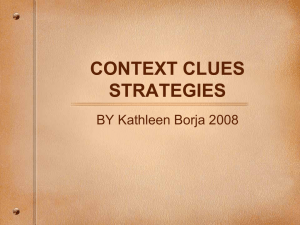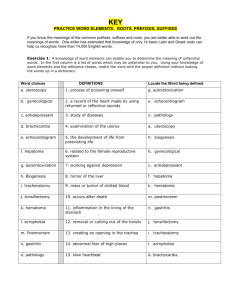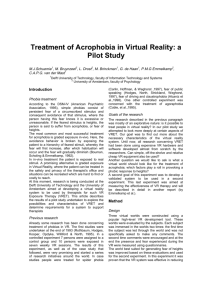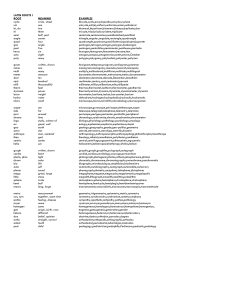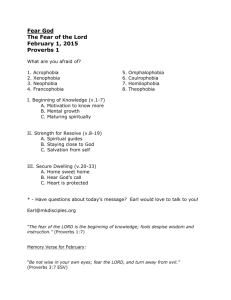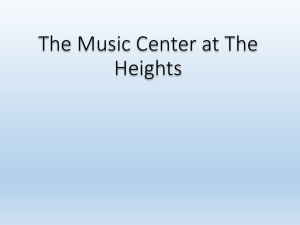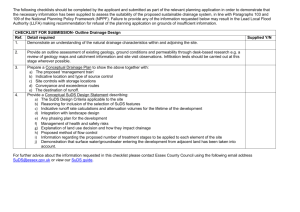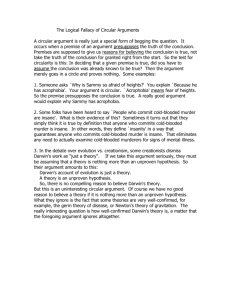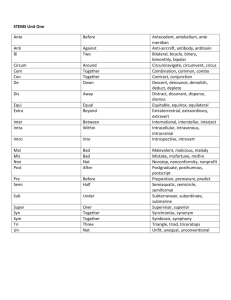Contrasting the Effectiveness and Efficiency of Virtual
advertisement
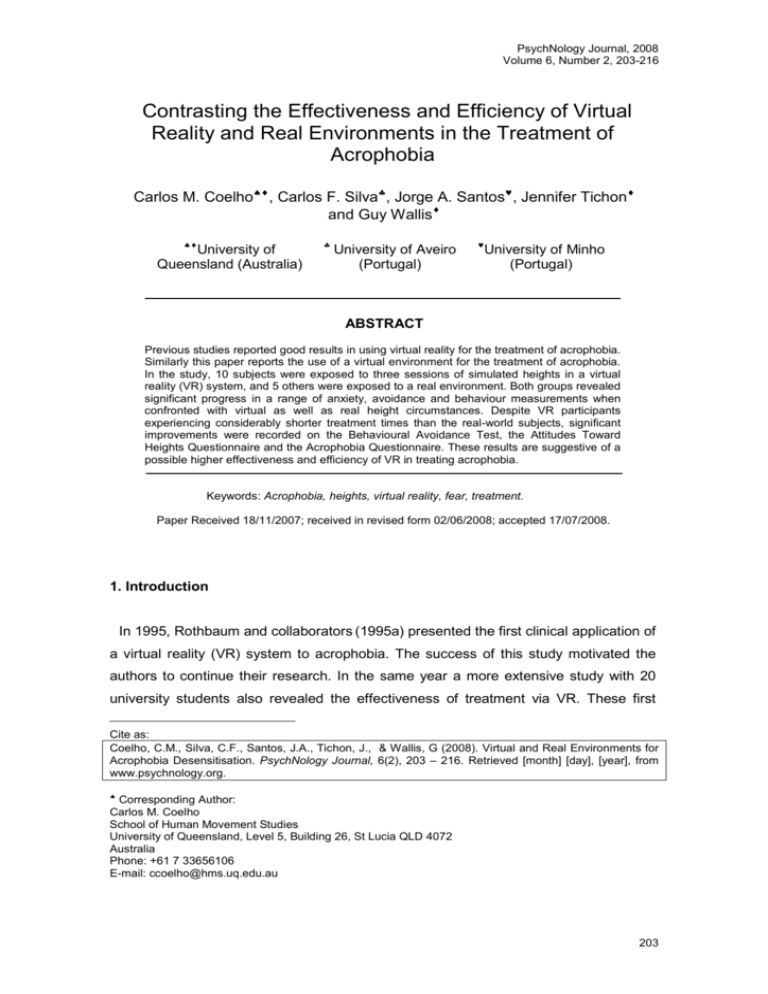
PsychNology Journal, 2008 Volume 6, Number 2, 203-216 Contrasting the Effectiveness and Efficiency of Virtual Reality and Real Environments in the Treatment of Acrophobia Carlos M. Coelho , Carlos F. Silva , Jorge A. Santos , Jennifer Tichon and Guy Wallis University of Queensland (Australia) University of Aveiro (Portugal) University of Minho (Portugal) ABSTRACT Previous studies reported good results in using virtual reality for the treatment of acrophobia. Similarly this paper reports the use of a virtual environment for the treatment of acrophobia. In the study, 10 subjects were exposed to three sessions of simulated heights in a virtual reality (VR) system, and 5 others were exposed to a real environment. Both groups revealed significant progress in a range of anxiety, avoidance and behaviour measurements when confronted with virtual as well as real height circumstances. Despite VR participants experiencing considerably shorter treatment times than the real-world subjects, significant improvements were recorded on the Behavioural Avoidance Test, the Attitudes Toward Heights Questionnaire and the Acrophobia Questionnaire. These results are suggestive of a possible higher effectiveness and efficiency of VR in treating acrophobia. Keywords: Acrophobia, heights, virtual reality, fear, treatment. Paper Received 18/11/2007; received in revised form 02/06/2008; accepted 17/07/2008. 1. Introduction In 1995, Rothbaum and collaborators (1995a) presented the first clinical application of a virtual reality (VR) system to acrophobia. The success of this study motivated the authors to continue their research. In the same year a more extensive study with 20 university students also revealed the effectiveness of treatment via VR. These first Cite as: Coelho, C.M., Silva, C.F., Santos, J.A., Tichon, J., & Wallis, G (2008). Virtual and Real Environments for Acrophobia Desensitisation. PsychNology Journal, 6(2), 203 – 216. Retrieved [month] [day], [year], from www.psychnology.org. Corresponding Author: Carlos M. Coelho School of Human Movement Studies University of Queensland, Level 5, Building 26, St Lucia QLD 4072 Australia Phone: +61 7 33656106 E-mail: ccoelho@hms.uq.edu.au 203 , C.M. Coelho, C.F. Silva, J.A. Santos, J. Tichon, G. Wallis exploratory studies had some limitations related to the absence of a comparison group, who had been exposed to standard treatment. A more recent study (Emmelkamp, Krijn, Hulsbosch, de Vries, Schuemie, & van der Mast, 2002) reproduced the places used in real exposure in a virtual environment. Three weekly one-hour sessions were applied to 33 acrophobic subjects (16 real-world and 17 VR). The VR treatment was as effective as real-world exposure in combating anxiety and avoidance. In contrast to the earlier studies, it was shown that the improvements were demonstrated not only in the self-report, Attitude Towards Heights Questionnaire (ATHQ), but also in the Behavioural Avoidance Test (BAT). These improvements were still present in a 6-month follow-up. A considerable number of studies have now demonstrated the effectiveness of exposure provided by VR systems in the treatment of acrophobia (see Krijn, Emmelkamp, Olafsson, & Biemond, 2004 for a review). Interestingly, Emmelkamp, Bruynzeel, Drost, and van der Mast's (2001) study unintentionally revealed a further benefit of VR sessions for acrophobia, namely, that improved effects were gained more quickly. In their study, all participants received VR treatment in the first two sessions as a first treatment. The subsequent real-world exposure did not lead to a significant improvement in the ATHQ or in the BAT. Since the first treatment was in VR for all participants, the research design unexpectedly created a ceiling effect, leaving little space for improvement in subsequent treatment in the real environment. Therefore, there were more positive results than expected after only two treatment sessions of VR. Time effectiveness in VR is important, especially when using head-mounted displays (HMDs), which easily disrupt visuo-vestibular and proprioceptive signals (Durlach & Mavor, 1995; Emura & Susumu, 1998; Lawson, Graeber, Mead, & Muth, 2002; Kennedy, Jones, Stanney, Ritter, & Drexler, 1996) and cause motion sickness (Reason & Brand, 1975; Stanney, Mourant, & Kennedy, 1998; Kennedy, Stanney, & Dunlap, 2000). Kennedy, Stanney, and Dunlap (2000) recommended short and repeated VR exposures with an interval of a few days. This suggests that the effectiveness of VR treatment needs to be fast, so as to achieve positive results before the onset of motion sickness. The aim of the present study was to compare the effectiveness of real world exposure versus VR exposure in a between-group design of acrophobic patients with varied exposure times. VR treatments were restricted to an average exposure time of 204 Virtual and Real Environments for Acrophobia Desensitisation approximately 22 minutes per session, while the real environment treatment group received approximately 50 minutes of exposure per session. In accordance with Emmelkamp et al.'s (2001) findings we expect to see a positive treatment outcome in VR and at least as quickly, if not more quickly, than when using traditional real-world exposure. We also expect to avoid severe motion sickness by implementing Kennedy et al’s (2000) recommendations. 2. Materials and Methods 2.1 Participants The participants of this study were individuals suffering from acrophobia who referred themselves for treatment after advertisements (e-mail and local newspaper) were posted around the university campus. Twenty-eight subjects were submitted to a screening process. Eight were excluded for not fulfilling the DSM-IV criteria of acrophobia. Two subjects were excluded because they showed fear of heights in the BAT but not in the VR environment. Another 3 participants abandoned treatment; one due to a long-term holiday and two for unknown reasons. Thus, there were 15 subjects without cardiac or vestibular problems, with normal or corrected-to-normal vision, and with a significant fear of heights, presenting a value of at least 5 on the Subjective Units of Disturbance Scale (SUDS) (Wolpe, 1982) in the last step of the BAT stairs (see the next section on methodological details). The participants comprised 5 men and 10 women, with ages ranging from 18 to 66 years old (mean 37). They all reported suffering a fear of heights over a period ranging from 18 to 55 years. Seven participants reported fear of heights for as long as they could remember. The average beginning age of fear was 5 years old. 2.2 Materials Our software, VRPhobias, was developed using Genes (Generic Environment Simulator), which is a simulator of virtual environments running on top of Performer. The virtual environment recreated the view from the balcony of a hotel. A gradual exposure to height was possible, as the subject rose from the 1st to the 8th storey of the building (total of 24 meters). The geometrical and pictorial characteristics of the façade and buildings facing of the hotel were reproduced in the virtual environment as accurately as possible. The VR scenario did not have moving agents (e.g., people or vehicles) and differed slightly from the real environment in visual detail, resolution, 205 , C.M. Coelho, C.F. Silva, J.A. Santos, J. Tichon, G. Wallis colours and dynamic response to movement. The software specified the corresponding height in floors and the equivalent height to the real perspective of the subject in the hotel (see Figure 1). In our laboratory, participants were close to a balcony rail similar to those found in the hotel. The workstation was a Silicon Graphics, Octane MXE model. The helmet (HMD) was a V6 model — Virtual Reality Research Systems Inc. The system was able to generate the virtual scenario at a rate of about 20–24 frames per second. The tracker was an electromagnetic unit (FASTRACKTM, Polhemus Inc.). Figure 1. View from the real world (left) and from the virtual reality system (right). 2.3 Instruments The Kennedy, Lane, Berbaum, and Lilienthal (1993) Simulator Sickness Questionnaire (SSQ) was used only to guarantee the participants’ safety, as VR environments may provoke symptoms of cybersickness. The questionnaire was applied before and after the first session. Each time the subjects felt severe symptoms, they were invited, in subsequent sessions, to move their heads more slowly, and remove the helmet and rest after reducing the anxiety associated with a fear of heights. The SUDS (Wolpe, 1982) questionnaire asks respondents to quantify their present level of distress on a l0-point scale. SUDS was used approximately every 5 minutes during the treatment session to determine whether clients were able to proceed to higher levels of exposure or wait for habituation to occur. The SUDS was also used as a pre- and post-treatment measure of anxiety. 206 Virtual and Real Environments for Acrophobia Desensitisation The anxiety subscale of the Acrophobia Questionnaire (AQ) (Cohen, 1997) was used. This questionnaire describes 20 situations with rating scales to assess anxiety (range 0–6) and avoidance (range 0–3), adding to a total score of between 0 and 180. This test has two subscales: one of anxiety (range 0–120) and another of avoidance (range 0–60). The ATHQ, developed by Abelson and Curtis (1989), includes six semantic scales, rated between 0 and 10, on which the subjects note down their attitudes towards high places. This scale provides for a measurement of two attitude variables: 1) cognitive assessment (good/bad, attractive/terrible, pleasant/unpleasant); and 2) danger assessment (safe/dangerous, non-threatening/threatening, harmless/harmful) (Table 1). The Behavioural Avoidance Test (BAT), which was also used, requests subjects to climb a staircase of 40 steps. The subjects are invited to climb five steps at a time and stop for about 10 seconds to explore the surrounding environment. During this pause, the SUDS test is administered. This procedure progresses until the participant is unable to climb any further or until the end of the stairs. The therapist accompanies the participant along the first 10 steps, in order to better explain the exercise, after which he observes the subject from the floor level. In order to compare the subjects in the behavioural tests, we created a measure of difficulty in heights, which we named the Level of Heights Difficulty (LHD). This measure, which had been used in our previous studies (e.g., Coelho, Santos, Silvério, & Silva, 2006), is the product of the number of sets of stairs that the subject can climb using the BAT, by the anxiety he/she manifests in SUDS. The LHD varies from “no difficulty” (value 0), which corresponds to climbing all sets of stairs (8 sets of 5 steps each) without anxiety (SUDS=0) to “maximum difficulty” (value 80), which corresponds to not climbing any stairs and experiencing the maximum disturbance (SUDS=10). The sets of stairs are counted backwards: 0–5 steps (1st set) = value 8; 6–10 steps (2nd set) = value 7; 11–15 steps (3rd set) = value 6 and so on until 36–40 steps (8th set) = value 1. For example, a subject who attained the 5th set, in this case with value 4, and obtained a SUDS=6, has a LHD=4x6 = 24. 2.4 Procedures Participants took part in 3 weekly sessions, conduced by a clinical psychologist. Before starting the first evaluation session, participants were informed about the exposure procedures, and gave their informed written consent. The overall study 207 , C.M. Coelho, C.F. Silva, J.A. Santos, J. Tichon, G. Wallis involved two different experiments. One experiment involved a group of acrophobics treated in a VR environment (n=10) and another group was treated within a real environment (n=5), with the visual characteristics of the VR environment being kept as close as possible to those of the real environment. Participants were not aware of the existence of two different treatment settings. Both assessment and treatment were free of charge. The therapist offered verbal orientation and encouragement to each participant and told him/her that he/she was capable of approaching the balcony, climbing to the various floors and reporting reduced values of subjective distress units. The participants were continuously instructed to look at the floor, explore the environment and stay as long as they could in each situation, until their anxiety diminished. The therapist could observe where each participant was in the virtual environment on a screen, and comment appropriately, as would be expected in a conventional exposure. When anxiety diminished (evaluated by means of SUDS, varying between 0 and 10), the therapist introduced the patient to a higher floor or encouraged the participant to approach the balcony rail. This process was then repeated floor by floor. In order to avoid motion sickness symptoms, participants were encouraged to stop and rest at the first signs of nausea or discomfort. When the anxiety levels diminished (assessed through SUDS, varying between 0–10), the therapist would introduce the patient onto a higher floor or would bring him or her closer to the railing of the balcony, and repeat the process. After about 30 minutes, the session would end; however, the abandonment at a moment of high anxiety was prevented, so it would not facilitate avoidance. The next session would start from where the last session had ended. The therapist’s comments were essentially identical to those expected in a real-world exposure; for example: “Can you try to take your hands off the balcony railing?”; “Would you like to get closer to the balcony?”; “We can now try to walk from one side of the balcony to the other”; “Everything is going well: your anxiety is diminishing by remaining in that situation”. The therapist would also question the subject about his or her thoughts and physical sensations. Participants were not encouraged to undertake exposure exercises outside the therapeutic sessions, and were also advised to avoid alcohol and to sleep normally before each session, in order to prevent increased susceptibility to motion sickness. 208 Virtual and Real Environments for Acrophobia Desensitisation 3. Results The results presented here refer to the SUDS during the behavioural exam (BAT), the AQ and the ATHQ. For the statistical analysis of each group the Wilcoxon test was used and for the comparison between the two groups, the Mann-Witney U test was applied. The group that participated in the treatment through VR exposure was called Group VR, and the group that participated in the treatment through real-world exposure Group R. 3.1 Real Environment Treatment Results Despite the low number of participants in Group R, statistically significant results were obtained for the LHD (Z=-2.032; p<0.05), the ATHQ (Z=-2,023; p<0.05), as well as the AQ (Z=-2.032; p<0.05) (Figure 2). These values are in agreement with the fairly welldocumented power of exposure therapies for the fear of heights (e.g., Abelson & Curtis, 1989; Baker, Cohen, & Saunders, 1973; Emmelkamp & Felten, 1985; Marshall, 1985; Spencer & Conrad, 1989; Williams, Dooseman, & Kleinfield, 1984; Williams, Turner, & Peer, 1985). 60.0 50.0 43.4 43.2 40.0 22.8 24.6 30.0 22.8 pre post 14.6 20.0 10.0 SD=22.4 SD=5.2 SD=6.8 SD=15.8 SD=7.4 SD=7.9 0.0 1 Figure 2. Median values comparing the Level of Heights Difficulty, Attitude Towards Heights Questionnaire and the Acrophobia Questionnaire, in pre- and post-test (Group R). 209 , C.M. Coelho, C.F. Silva, J.A. Santos, J. Tichon, G. Wallis 3.2 VR Treatment Results Statistically significant results were obtained for the LHD (Z=-2.666; p<0.01), the ATHQ (Z=-2.703; p<0.01), as well as the AQ (Z=-2.094, p<0.05) (Figure 3) in Group VR. Again, the values are in close agreement with the known therapeutic power of VR exposure for the fear of heights treatment (e.g., Hodges et al., 1995; Rothbaum et al., 1995b; Emmelkamp et al., 2002). 60.0 47.7 47 50.0 33.6 40.0 26.7 30.0 pre 22.1 post 20.0 SD=12 10.0 SD=11.2 SD=9.3 5.8 SD=8.9 SD=13.3 SD=5.2 0.0 Figure 3. Median values comparing the Level of Heights Difficulty, Attitude Towards Heights Questionnaire and the Acrophobia Questionnaire, in pre- and post-test (VR Group). 3.3 Comparison of the Two Groups Before Treatment Comparing the two groups and considering the results obtained from the first assessment, there is no significant difference in AQ (U=19.0; p>0.05), ATHQ (U=19.0; p>0.05) and LHD (U=21.5; p>0.05). These results suggest that the groups were identical before treatment. 3.4 Comparison of the Differences Between the Two Groups In order to assess the differential effect of the two types of therapy, we analysed the differences between the values before and after treatment in each of the variables being studied for each therapeutic group (VR Group versus R Group). These variables were the SUDS, the LHD, the ATHQ and the AQ. The “pre–post” difference of medians was compared using the Mann-Whitney U test. 210 Virtual and Real Environments for Acrophobia Desensitisation The VR and R groups show no pre-post treatment differences, according to the Mann-Whitney test (U=17.5; p>0.05) regarding the SUDS. Regarding the LHD differences, the groups cannot be significantly distinguished regarding pre-post differences according to the Mann-Whitney test (U=13.0; p>0.05) (Table 1). Considering the differences in the ATHQ, the VR and R groups show no pre-posttreatment differences according to the Mann-Whitney test (U=24.5; p>0.05), and the groups showed no difference regarding the AQ values (U=19.0; p>0.05). LHD Median Amplitude VR Group -15.5 37 R Group -5 23 Table 1. Differences between the Level of Heights Difficulty. Comparing the two groups’ results obtained in the second assessment (post-test), no significant differences were shown in the AQ (U=17,0; p>0.05), ATHQ (U=21,5; p>0.05) and behaviour performance LHD (U=16,0; p>0.05). Overall results suggest that the groups were identical after treatment. We should stress that such similar therapeutic output was achieved despite the much shorter length of the virtual exposure compared to the real exposure (Figure 4). The average session time of the groups presented a significant difference (U= 0,000 p<0.01), being that the VR treatment took an average time of 22.3 minutes, much lower that that of the real-world treatment (51.7 minutes). Average session time in minutes 70 60 50 40 30 SD=22.1 20 10 SD=6.5 0 1 group1 (virtual) group2 (rea) Figure 4. Comparing session times for Virtual and Real Treatment Groups. 211 , C.M. Coelho, C.F. Silva, J.A. Santos, J. Tichon, G. Wallis 4. Discussion Overall, as indicated in prior research, our results suggest both the real-world and VR treatments were highly effective (e.g., Hodges et al., 1995; Rothbaum et al., 1995a; Rothbaum et al., 1995b; Emmelkamp et al., 2001; Emmelkamp et al., 2002). In the current study, VR treatment was determined to be at least as effective, if not more efficient that real-world exposure. VR offers a number of practical advantages over real-world exposure including: (i) better control of the situation by the therapist; (ii) avoidance of potential public embarrassment; (iii) maintenance of confidentiality; and (iv) comfort of the protective environment of the therapist’s office (Wiederhold & Wiederhold, 2005). In addition to these advantages our experience has been that VR provides a further advantage over traditional treatments by virtue of its ability to attract participants into treatment. The difference in numbers of participants between comparative groups in this project was due entirely to the fact that people were volunteering at twice the rate for the VR exposure group. It was much more difficult to find participants willing to volunteer for the real-world group. The VR treatment patients received less exposure time than the participants undergoing traditional treatment. Significantly, it was established that for the LHD, the VR Group presented a median of -15.5, while the R Group presented a median of -5 (Table 1), which means that the VR Group could climb more steps with less anxiety. One possible explanation for this large difference is the ability of the VR system to promote new visuo-vestibular skills in the participants (Whitney et al. 2005). Although the SUDS reported by participants throughout the sessions had decreased, indicating habituation, there was a temporary increase of the SUDS associated with approaching the balcony, physical movement, and increased height. Individual virtual environments may not produce exactly the same effects observed in this study. It is important when designing a suitable environment, that a range of realistic cues is offered, capable of making the subject feel threatened, and engendering in the subject the belief that their actions will have real consequences. 5. Limitations and Suggestions for Research Comparison of the two treatment types suggests that there is an advantage for training in a virtual environment. It may be that if the steps used in the BAT had been 212 Virtual and Real Environments for Acrophobia Desensitisation higher, a greater variation of results would have been obtained. Undertaking this modification in future research should achieve a change in the between and within group differences that results in statistical significance. It appears that limiting the number of steps to 40 provoked an undesirable ceiling effect. It is important to point out, therefore, that the absence of statistically significant differences between treatments might simply be due to a lack of experimental power (e.g., Agras & Jacob, 1981). Participant numbers were unevenly distributed. This difference was due to the comparative difficulty to recruit participants in enrolling the real world exposure group. Participants were informed by e-mail and local newspaper that VR was being used, free of charge, for the treatment of acrophobia. This personal preference of participants was difficult to manage. It is interesting that all study dropouts were applicants invited to participate in the real environment. While clearly resulting in a study limitation, this experience with participants also demonstrated unintentionally the potential of VR to attract people with phobias to treatment. A patient group is usually characterised by treatment avoidance (Boyd et al., 1990). Further studies are still needed to explore acrophobia. One particularly interesting future direction is a more detailed investigation of specific phobic triggers in height environments. VR systems offer exciting and novel opportunities for testing the role of these cues in a tightly controlled and independent manner (e.g., Loomis, Nlascovich, & Beal, 1999; Gaggioli, 2003). For example, head motion could be recorded during training, to provide a tighter causal link between self-motion and fear of heights. 6. Acknowledgements This research was funded by a Bial Foundation Grant (project Bial 39/98) and by a Science and Technology Foundation Grant (ref. SFRH/BPD/26922/2006). 7. References Abelson, J.L., & Curtis, G.C. (1989). Cardiac and neuroendocrine responses to exposure therapy in height phobics: Desyncrony within the “physiological response system”. Behaviour Research & Therapy, 27, 561-7. 213 , C.M. Coelho, C.F. Silva, J.A. Santos, J. Tichon, G. Wallis Agras, W.S., & Jacob, R.G. (1981). Phobia: Nature and Measurement. In Matig Mavissakalian & David H. Barlow (Eds.), Phobia: Psychological and Pharmacological Treatment (pp.35-62). New York: The Guilford Press. Baker, B.L., Cohen, D.C., & Saunders, J.T. (1973). Self-directed desensitization for acrophobia. Behaviour Research and Therapy, 11, 79-89. Boyd, J.H., Rae, D.S., Thompson, J.W., Burns, B.J., Bourdon, K., Locke, B.Z., & Regier, D.A. (1990). Phobia: prevalence and risk factors. Social Psychiatry and Psychiatric Epidemiology, 25, 314-323. Coelho, C.S.M.; Santos, J.A.; Silvério, J.A.S; & Silva, C.F. (2006). Virtual reality and acrophobia: one year follow-up and case study. Cyberpsychology and Behavior, 9(3), 336-341. Cohen, D.C. (1997). Comparison of self-report and overt-behavioral procedures for assessing acrophobia. Behavior Therapy; 8, 17-23. Durlach, N.I., & Mavor, A.S. (1995). Virtual reality: Scientific and technological challenges. Washington, DC: National Academy Press. Emmelkamp, P.M.G., Bruynzeel, M, Drost, L., Van der Mast, C.A.P.G. (2001). Virtual Reality Treatment in Acrophobia: A Comparison with Exposure In Vivo. Cyberpsychology and Behavior; 4, 335-339. Emmelkamp, P.M.G., & Felten, M. (1985). The process of exposure in vivo: Cognitive and physiological changes during treatment of acrophobia. Behaviour Research & Therapy, 23, 219-223. Emmelkamp, P.M.G., Krijn, M., Hulsbosch, L., de Vries, S., Schuemie, M. J., van der Mast, C.AP.G. (2002). Virtual Reality Treatment versus Exposure In Vivo: A Comparative Evaluation in Acrophobia. Behaviour Research & Therapy, 40, 509516. Emura, S., & Susumu, T. (1998). Multisensor integrated prediction for virtual reality. Presence: Teleoperators & Virtual Environments, 7, 410-423. Gaggioli, A. (2003). Using Virtual Reality in Experimental Psychology. In G. Riva & C. Galimberti (Eds.). Towards CyberPsychology: Mind, Cognitions and Society in the Internet Age (pp.157-174). Amsterdam: IOS Press. Hodges, L.F., Kooper, R.; Meyer, T.C., Rothbaum, B.O., Opdyke, D., Graaff, J.J., Williford, J.S., & North, M.M. (1995). Virtual environments for treating the fear of heights. IEEE Computer, 28, 27-34. 214 Virtual and Real Environments for Acrophobia Desensitisation Kennedy, R.S., Jones, M.B., Stanney, K.M., Ritter, A.D., & Drexler, J.M. (1996). Human factors safety testing for virtual environment mission-operation training. (Contract No. NAS9-19482, 6/96). Houston, TX: NASA Johnson Space Center. Kennedy, R.S, Lane, N.E, Berbaum, K.S, Lilienthal, M.G. (1993). Simulator sickness questionnaire: an enhanced method for quantifying simulator sickness. The International Journal of Aviation Psychology, 3, 203-20. Kennedy, R.S., Stanney, K.M., & Dunlap, W.P. (2000). Duration and exposure to virtual environments: sickness curves during and across sessions. Presence: Teleoperators and Virtual Environments, 9, 463-472. Krijn, M.; Emmelkamp, P. M. G.; Olafsson, R.P. & Biemond, R. (2004) Virtual reality exposure therapy of anxiety disorders: A review. Clinical Psychology Review, 24, 259-281. Lawson, B.D., Graeber, D.A., Mead, A.M., & Muth, E.R. (2002). Signs and symptoms of human syndromes associated with synthetic experiences. In K.M. Stanney (Ed.), Handbook of virtual environments, design, implementation, and applications, (pp.589-618). Mahwah: Lawrence Erlbaum Associates. Loomis, J.M., Nlascovich, J.J., & Beal, A.C. (1999). Immersive virtual environment technology as a basic research tool in psychology. Behavior Research Methods, Instruments & Computers, 31(4), 557-564. Marshall, W. L. (1985). The effects of variable exposure to flooding therapy. Behavior Therapy, 16, 117-135. Reason, J.T., & Brand, J.J. (1975). Motion sickness. London: Academic Press. Rothbaum, B., Hodges, L., Kooper, R., Opdyke, D., Williford, J., & North, M. (1995a). Virtual reality graded exposure in the treatment of acrophobia: a case report. Behavior Therapy, 26, 547-554. Rothbaum, B., Hodges, L., Kooper, R., Opdyke, D., Williford, J., & North, M. (1995b). Effectiveness of computer-generated (virtual reality) graded exposure in the treatment of acrophobia. American Journal of Psychiatry, 152, 626-628. Spencer, C.R., & Conrad, P.L. (1989). Treatment of acrophobia of an institutionalized adult with mental retardation. Mental Retardation, 27, 1-4. Stanney, K.M., Mourant, R.R., & Kennedy, R.S. (1998). Human factors issues in virtual environments: a review of the literature. Presence: Teleoperators and Virtual Environments, 7, 327-351. 215 , C.M. Coelho, C.F. Silva, J.A. Santos, J. Tichon, G. Wallis Whitney, S.L., Jacob, R.G., Sparto, P.J., Olshansky, E.F., Detweiler-Shostak, G., Brown, E.L., & Furman, J.M. (2005). Acrophobia and pathological height vertigo: indications for vestibular physical therapy? Physical Therapy, 85, 443-458. Wiederhold, B. K., & Wiederhold, M. D. (2005). Virtual reality therapy for anxiety disorders. Advances in evaluation and treatment. Washington: American Psychological Association. Williams, S.L., Dooseman, G., & Kleinfield, E. (1984). Comparative effectiveness of guided mastery and exposure treatments for intractable phobias. Journal of Consulting and Clinical Psychology, 52, 505-518. Williams, S.L., Turner, S.M., & Peer, D.F. (1985). Guided mastery and performance desensitization for severe acrophobia. Journal of Consulting and Clinical Psychology, 53, 237-247. Wolpe, J. (1982). The Practice of Behavior Therapy (3rd ed.). Oxford: Pergamon Press. 216
